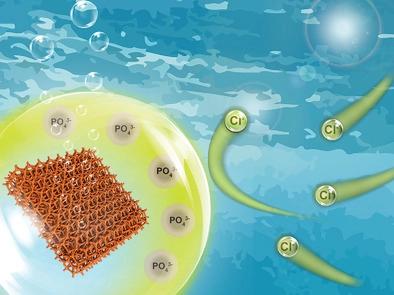Our official English website, www.x-mol.net, welcomes your
feedback! (Note: you will need to create a separate account there.)
High Corrosion Resistance of NiFe-Layered Double Hydroxide Catalyst for Stable Seawater Electrolysis Promoted by Phosphate Intercalation
Small ( IF 13.0 ) Pub Date : 2022-10-03 , DOI: 10.1002/smll.202203852
Baoshan Zhang 1 , Shuo Liu 1 , Shaojie Zhang 1 , Yu Cao 1 , Huili Wang 1 , Chengyu Han 1 , Jie Sun 1
Small ( IF 13.0 ) Pub Date : 2022-10-03 , DOI: 10.1002/smll.202203852
Baoshan Zhang 1 , Shuo Liu 1 , Shaojie Zhang 1 , Yu Cao 1 , Huili Wang 1 , Chengyu Han 1 , Jie Sun 1
Affiliation

|
Sustainable production of hydrogen from seawater electrolysis has attracted much attention in recent years. Considering that Cl- might corrode metal substrate by crossing through the covered catalyst, the conventional Ni(II)Fe(III)-layered double hydroxide (NiFe-LDH) loaded on metal substrate, as a favorable oxygen evolution catalyst, cannot be directly used for seawater electrolysis. Herein, an anti-corrosion strategy of PO43- intercalation in NiFe-LDH is proposed, in which the highly negatively charged PO43- in the interlayers can prevent the Ni substrate from Cl- corrosion by electrostatic repulsion. In order to verify the anti-corrosion effect, the two electrodes of the pristine NiFe-LDH and the PO43- intercalated NiFe-LDH are evaluated in a solution with high Cl- concentration. PO43- can effectively hinder the migration of Cl- between the interlayers of NiFe-LDH, thus the corrosion life of the PO43- intercalated NiFe-LDH is more than 100 times longer than that of the pristine NiFe-LDH. The improvement of stability is attributed to the inhibition effect of Cl- passing through the interlayers of NiFe-LDH, leading to the protection of Ni substrate. This work provides a design strategy for the catalysts loaded on the metal substrate, which has excellent Cl--corrosion resistance and can be widely used in hydrogen generation from seawater electrolysis.
中文翻译:

NiFe 层状双氢氧化物催化剂的高耐腐蚀性,用于磷酸盐插层促进的稳定海水电解
近年来,海水电解制氢的可持续生产备受关注。考虑到 Cl -可能通过覆盖的催化剂腐蚀金属基底,传统的 Ni(II)Fe(III)-层状双氢氧化物 (NiFe-LDH) 负载在金属基底上,作为一种有利的析氧催化剂,不能直接使用用于海水电解。在此,提出了一种在NiFe-LDH中嵌入PO 4 3-的防腐策略,其中夹层中带高负电荷的PO 4 3-可以通过静电排斥作用防止Ni基体受到Cl -腐蚀。为了验证防腐效果,将纯NiFe-LDH和PO的两个电极4 3-插层 NiFe-LDH 在具有高 Cl -浓度的溶液中进行评估。PO 4 3-可以有效地阻碍Cl -在NiFe-LDH层间的迁移,因此PO 4 3-插层NiFe-LDH的腐蚀寿命是原始NiFe-LDH的100倍以上。稳定性的提高归因于Cl -通过NiFe-LDH层间的抑制作用,从而保护了Ni基底。这项工作为负载在金属基底上的催化剂提供了一种设计策略,它具有优异的 Cl --耐腐蚀,可广泛用于海水电解制氢。
更新日期:2022-10-03
中文翻译:

NiFe 层状双氢氧化物催化剂的高耐腐蚀性,用于磷酸盐插层促进的稳定海水电解
近年来,海水电解制氢的可持续生产备受关注。考虑到 Cl -可能通过覆盖的催化剂腐蚀金属基底,传统的 Ni(II)Fe(III)-层状双氢氧化物 (NiFe-LDH) 负载在金属基底上,作为一种有利的析氧催化剂,不能直接使用用于海水电解。在此,提出了一种在NiFe-LDH中嵌入PO 4 3-的防腐策略,其中夹层中带高负电荷的PO 4 3-可以通过静电排斥作用防止Ni基体受到Cl -腐蚀。为了验证防腐效果,将纯NiFe-LDH和PO的两个电极4 3-插层 NiFe-LDH 在具有高 Cl -浓度的溶液中进行评估。PO 4 3-可以有效地阻碍Cl -在NiFe-LDH层间的迁移,因此PO 4 3-插层NiFe-LDH的腐蚀寿命是原始NiFe-LDH的100倍以上。稳定性的提高归因于Cl -通过NiFe-LDH层间的抑制作用,从而保护了Ni基底。这项工作为负载在金属基底上的催化剂提供了一种设计策略,它具有优异的 Cl --耐腐蚀,可广泛用于海水电解制氢。































 京公网安备 11010802027423号
京公网安备 11010802027423号